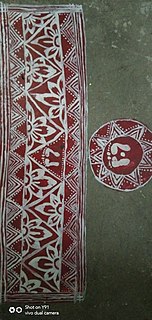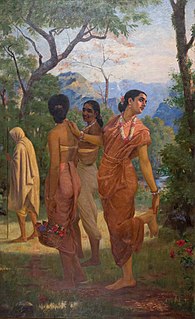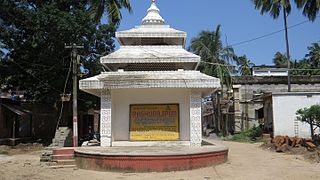 W
WIndian painting has a very long tradition and history in Indian art, though because of the climatic conditions very few early examples survive. The earliest Indian paintings were the rock paintings of prehistoric times, such as the petroglyphs found in places like Bhimbetka rock shelters. Some of the Stone Age rock paintings found among the Bhimbetka rock shelters are approximately 10,000 years old.
 W
WAipan is an established-ritualistic folk art originating from Kumaon in the Indian Himalayas. The art is done mainly during special occasions, household ceremonies and rituals. Practitioners believe that it invokes a divine power which brings about good fortune and deters evil. The art is special as it is done on empty walls, which are brick-red in color, called Geru. The actual art is done with a white paste made of rice flour. The art is frequent to floors and walls of Puja rooms and entrances of homes. It is also practiced mostly by Kumaoni women. The art form has great social, cultural and religious importance.
 W
WThe Buddhist Caves in Ajanta are approximately 30 rock-cut Buddhist cave monuments dating from the 2nd century BCE to about 480 CE in the Aurangabad district of Maharashtra state in India. The caves include paintings and rock-cut sculptures described as among the finest surviving examples of ancient Indian art, particularly expressive paintings that present emotions through gesture, pose and form.
 W
WAlpana or alpona refers to colourful motifs, sacred art or painting done with hands and paint which is mainly a paste of rice and flour on auspicious occasions in Bengal. The word Alpana is derived from the Sanskrit alimpana, which means 'to plaster' or 'to coat with'. Traditionally, it was drawn by the women of the house before sunset. It is also a folk art in Bengal.
 W
WAnangpur is a historical village located near Faridabad in Haryana, India. Anangpur forms a geographical triangle along with Mehrauli and Tugluqabad. It was the earliest settlement of the Tomara dynasty. Anangpur was the capital of the Tomar king, Anangpal Tomar.
 W
WThe Anis Al-Hujjaj is a seventeenth-century literary work by Safi ibn Vali, an official of the Mughal court in what is now India. Written in Persian, it describes the Hajj undertaken by him in 1677 AD and it gives advice to pilgrims. Its illustrations depict pilgrims travelling to the holy sites and taking part in the rituals of the Hajj. They are also a visual guide to significant places and people.
 W
WThe Ashta-Nayika is a collective name for eight types of nayikas or heroines as classified by Bharata in his Sanskrit treatise on performing arts - Natya Shastra. The eight nayikas represent eight different states (avastha) in relationship to her hero or nayaka. As archetypal states of the romantic heroine, it has been used as theme in Indian painting, literature, sculpture as well as Indian classical dance and music.
 W
WBani Thani was a singer and poet in Kishangarh in the time of Raja Samant Singh (1748–1764), whose mistress she became. After he abdicated the throne the couple retired to a comfortable life in Brindavan, a place associated with the life of Krishna, to whom Samant Singh was greatly devoted. A group of Indian paintings of around 1750 attributed to Nihâl Chand from the Marwar school of Kishangarh show Krishna and Radha, using the same models, who are assumed to be Sawant Singh and Bani Thani.
 W
WBasohli (Basoli) formerly Vishwasthali is a town in Kathua district in the union territory of Jammu and Kashmir, India. It is situated on the right bank of River Ravi at an altitude of 1876 ft. It was founded by Raja Bhupat Pal sometime in 1635. It was known for the palaces which are now in ruins and miniatures paintings. The Battle of Basoli was fought in the area.
 W
WThe history of cave paintings in India or rock art range from drawings and paintings from prehistoric times, beginning in the caves of Central India, typified by those at the Bhimbetka rock shelters from around 10,000 BP, to elaborate frescoes at sites such as the rock-cut artificial caves at Ajanta and Ellora, extending as late as 6th – 10th century CE.
 W
WThe Hamzanama or Dastan-e-Amir Hamza narrates the legendary exploits of Amir Hamza, or Hamza ibn Abdul-Muttalib, an uncle of Muhammad. Most of the stories are extremely fanciful, "a continuous series of romantic interludes, threatening events, narrow escapes, and violent acts". The Hamzanama chronicles the fantastic adventures of Hamza as he and his band of heroes fight against the enemies of Islam.
 W
WIdital or Edital is a form of Indian painting from the state of Odisha. It is a kind of Saura painting that was invented and is practiced by the Sora people who mostly live in Rayagada, Gajapati and Koraput districts of Odisha. The artisans paint Idital as a symbol of devotion to the tribal deity "Idital" or "Edital". Each piece of Idital painting contains symbols and signs and each one of them convey a distinct meaning. "Jodisum" and "Jananglasum" are two known Idital styles.
 W
WThe Sitabenga and Jogimara Caves, sometimes referred to either as Sitabenga Cave or Jogimara Cave, are ancient cave monuments nested in the north side of Ramgarh hills in Puta village, Chhattisgarh, India. Dated between the 3rd-century BCE to 1st-century BCE, they are notable for their non-religious inscriptions in Brahmi script and Magadhi language, and one of the oldest colored frescoes in Asia. Some scholars state that the Sitabenga cave is the oldest performance theatre on the Indian subcontinent, but others question whether it was indeed a theatre and suggest that it may have been a resting place (dharmashala) along an ancient trade route. The inscription at the Jogimara cave is equally disputed, with one translation interpreting it as a love-graffiti by a girl and a boy, while another translation interpreting it as a female dancer and a male sculptor-painter creating the two caves together to serve others. The inscription is also the oldest known mention of the word "devadasi", but this seems just a name and it is unlikely that this was related to any ancient Indian temple since the site and nearby area has no evidence of any Buddhist, Hindu or Jain temple built between the 3rd-century BCE and 8th-century CE.
 W
WThe "Kamangiri art" or Kamangiri bhint chitro is a form of mural painting commissioned primarily in Kutch region of Indian state of Gujarat as well as some regions of Pakistan.
 W
WKangra painting is the pictorial art of Kangra, named after Kangra, Himachal Pradesh, a former princely state, which patronized the art. It became prevalent with the fading of Basohli school of painting in mid-18th century, and soon produced such a magnitude in paintings both in content as well as volume, that the Pahari painting school, came to be known as Kangra paintings.
 W
WMandana paintings are wall and floor paintings of Rajasthan and Madhya Pradesh, India. Mandana are drawn to protect home and hearth, welcome gods into the house and as a mark of celebrations on festive occasions. Meena women in the Hadoti area of Rajasthan possess skill for developing designs of perfect symmetry and accuracy. The art is practised on the floor and wall. The art is much more pronounced and attached to Meena community of Hadoti area. The ground is prepared with cow dung mixed with rati, a local clay, and red ochre. Lime or chalk powder is used for making the motif. Tools employed are a piece of cotton, a tuft of hair, or a rudimentary brush made out of a date stick. The design may show Ganesha, peacocks, women at work, tigers, floral motifs, etc. Such paintings are also called Mandala in most of the parts of Nepal.
 W
WThe modern Indian art movement in Indian painting is considered to have begun in Calcutta in the late nineteenth century. The old traditions of painting had more or less died out in Bengal and new schools of art were started by the British. Initially, protagonists of Indian art such as Raja Ravi Varma drew on Western traditions and techniques including oil paint and easel painting. A reaction to the Western influence led to a revival in primitivism, called as the Bengal school of art, which drew from the rich cultural heritage of India. It was succeeded by the Santiniketan school, led by Rabindranath Tagore's harking back to idyllic rural folk and rural life. Despite its country-wide influence in the early years, the importance of the School declined by the 'forties' and now it is as good as dead.
 W
WMughal painting is a particular style of South Asian, particularly North Indian, painting confined to miniatures either as book illustrations or as single works to be kept in albums (muraqqa). It emerged from Persian miniature painting and developed in the court of the Mughal Empire of the 16th to 18th centuries. The Mughal emperors were Muslims and they are credited with consolidating Islam in South Asia, and spreading Muslim arts and culture as well as the faith.
 W
WA Muraqqa is an album in book form containing Islamic miniature paintings and specimens of Islamic calligraphy, normally from several different sources, and perhaps other matter. The album was popular among collectors in the Islamic world, and by the later 16th century became the predominant format for miniature painting in the Persian Safavid, Mughal and Ottoman empires, greatly affecting the direction taken by the painting traditions of the Persian miniature, Ottoman miniature and Mughal miniature. The album largely replaced the full-scale illustrated manuscript of classics of Persian poetry, which had been the typical vehicle for the finest miniature painters up to that time. The great cost and delay of commissioning a top-quality example of such a work essentially restricted them to the ruler and a handful of other great figures, who usually had to maintain a whole workshop of calligraphers, artists and other craftsmen, with a librarian to manage the whole process.
 W
WMangar Bani, a paleolithic archaeological site and sacred grove hill forest next to the Mangar village on Delhi-Haryana border, is in the South Delhi Ridge of Aravalli mountain range in Faridabad tehsil of Faridabad district in the Indian state of Haryana. It lies, immediate south of India's national capital Delhi, within NCR.
 W
WPabuji Ki Phad is a religious scroll painting of folk deities, which is used for a musical rendition of the only surviving ancient traditional folk art form, Phad painting in the world of the epic of Pabuji, the Rathod Rajput chief. Bhopas of Pabusar are the bards and also priests who are the traditional narrators of this art form. The Phad is also spelt as “Par.” This art form is popular in the Indian state of Rajasthan. Literally, 'Pabuji Ki Phad' translates into two versions namely, "The Screen of Pabuji or O, Read of Pabuji!. Pabuji is also known as "the Ascetic Deity of Sand Desert".
 W
WPichhwai are large devotional Hindu painted pictures, normally on cloth, which portray Krishna. They are mainly made to hang in Hindu temples of the Pushtimarg devotional tradition, especially the Shrinathji Temple in Nathdwara, Rajasthan, built around 1672. They are hung behind the idol of Shrinathji, a local form of Krishna and the centre of Pushtimarg worship, to depict his leelas. Aurangabad was another area associated with them. The purpose of Pichhwais, other than artistic appeal, is to narrate tales of Krishna to the illiterate. Temples have sets with different images, which are changed according to the calendar of festivals celebrating the deity.
 W
WThe Pitalkhora Caves, in the Satamala range of the Western Ghats of Maharashtra, India, are an ancient Buddhist site consisting of 14 rock-cut cave monuments which date back to the third century BCE, making them one of the earliest examples of rock-cut architecture in India. Located about 40 kilometers from Ellora, the site is reached by a steep climb down a flight of concrete stairs, past a waterfall next to the caves.
 W
WPithora is a ritualistic painting done on the walls by the Rathwa and Bhilala tribes.
 W
WRagamala paintings are a form of Indian miniature painting, a set of illustrative paintings of the Ragamala or "Garland of Ragas", depicting variations of the Indian musical modes called ragas. They stand as a classical example of the amalgamation of art, poetry and classical music in medieval India.
 W
WRaghurajpur is a heritage crafts village out of Puri district, India, known for its master Pattachitra painters, an art form which dates back to 5 BC in the region and Gotipua dance troupes, the precursor to the Indian classical dance form of Odissi. It is also known as the birthplace of one of the finest and Legendary Odissi exponents Padma Vibhushan Guru, Kelucharan Mohapatra and Gotipua Dancer Padma Shri Guru, Maguni Charan Das. It is also the birth place of Shilp Guru Dr. Jagannath Mahapatra who is a prominent Pattachitra Artist and has a huge contribution on the development of Pattachitra art and Raghurajpur village. Apart from that, the village is also home to crafts like Tussar paintings, Palm leaf Engravings, Stone carvings, Wood carvings, Cowdung toys and Papier mache toys, and masks.
 W
WRickshaw art or auto art is a form of neo-romanticism emerging in Bangladesh.
 W
WThe Sitabhinji Group of Rock Shelters, also referred to as the Ravanachhaya Mural Rocks, is a 4th to 6th century CE rock-cut monument with a major painted mural and inscriptions near Danguapasi village of Kendujhar (Keonjhar) district of Odisha. Archaeological excavations after the 1950s have unearthed boulder sections with additional inscriptions in Sanskrit and early Odiya, coins and parts of pre-8th-century Hindu temple and artwork from the Bhanja dynasty.
 W
WWarli painting is a form of tribal art mostly created by the tribal people from the North Sahyadri Range in Maharashtra, India. This range encompasses cities such as Dahanu, Talasari, Jawhar, Palghar, Mokhada, and Vikramgad of Palghar district. This tribal art was originated in Maharashtra, where it is still practiced today.
 W
W